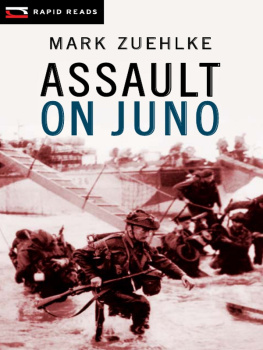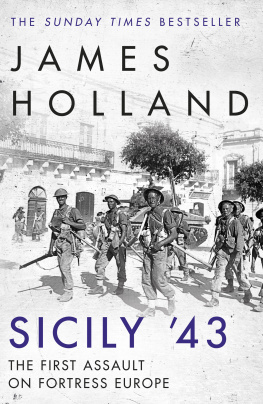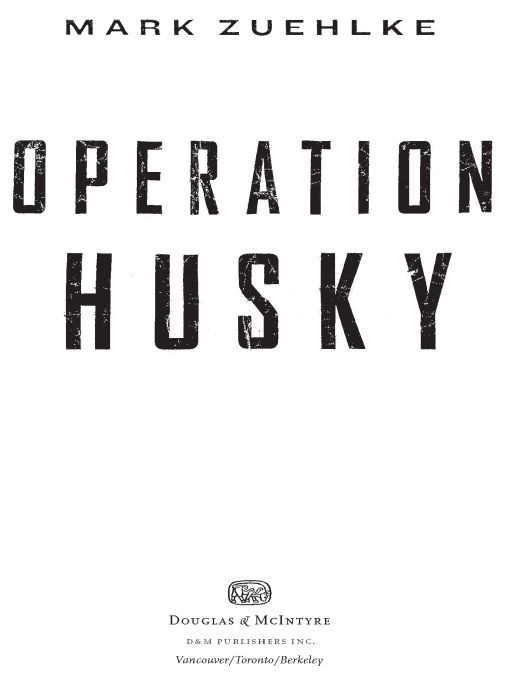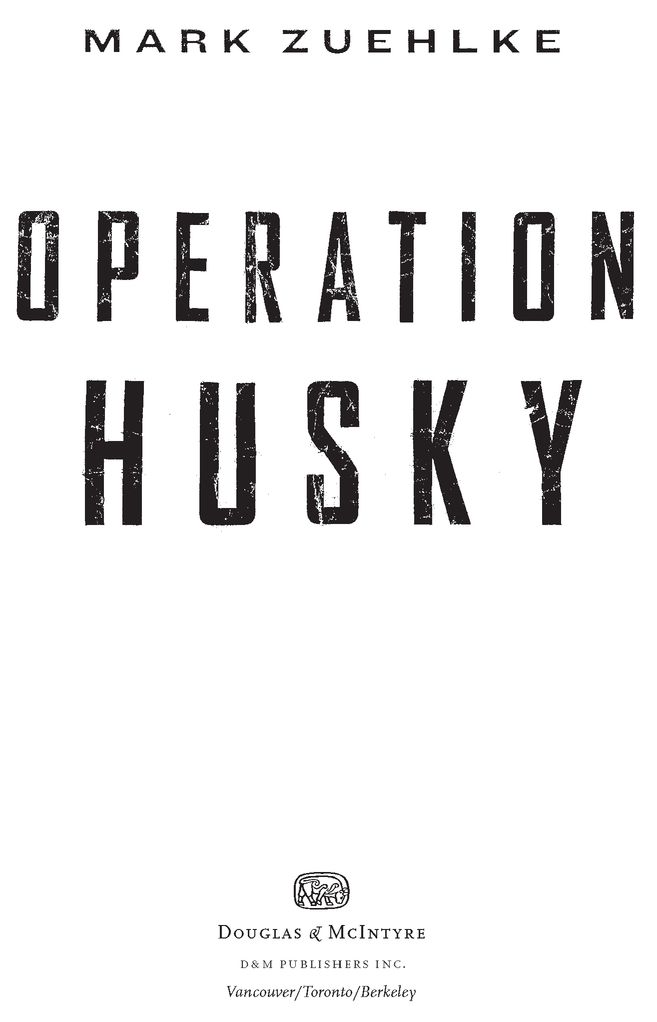Table of Contents
THE CANADIAN INVASION OF SICILY,
JULY10AUGUST7, 1943
OTHER MILITARY HISTORY BOOKS BY MARK ZUEHLKE
Terrible Victory: First Canadian Army and the Scheldt Estuary
Campaign, September 13-November 6, 1944
Holding Juno: Canadas Heroic Defence of the
D-Day Beaches: June 712, 1944
Juno Beach: Canadas D-Day Victory: June 6, 1944
The Gothic Line: Canadas Month of Hell in World War II Italy
The Liri Valley: Canadas World War II Breakthrough to Rome
Ortona: Canadas Epic World War II Battle
The Canadian Military Atlas: Four Centuries of Conflict from
New France to Kosovo (with C. Stuart Daniel)
The Gallant Cause: Canadians in the
Spanish Civil War, 1936-1939
For Honours Sake: The War of 1812
and the Brokering of an Uneasy Peace
4/5 July 1943
Dear Family:
I am very proud and happy in the knowledge that I am going to lead a Company of so fine a Regiment in an Assault Landing such as we are going to do in the early morning of next Saturday. I talk to them in their mess deck, telling them of the specific jobs, etc. and I am a lucky man indeed to have such a good lot of lads under my command. The average age is 24, although there are a number who, claiming 20, look about 18. In their shorts and open-necked, rolled-up sleeved shirts they look like a bunch of Boy Scouts. It is hard to believe that these Western Ontario school boys of 1939, and in some cases later, are the tough assault troops which will be the newspapers probable description of them.
They all have fighting spirit, but are school boyish in their enthusiasm; it seems a shame that so many of these splendid fellows will be dead or wounded before this week is out.
Captain Strome Galloway, Royal Canadian Regiment
PREFACE
WITH THE 1999 publication of Ortona: Canadas Epic World War II Battle, I unwittingly committed myself to a series of books chronicling the Canadian Armys World War II experience. I say unwittingly, because during the research and writing of Ortona, no thought had been given to its being the first in a series. There was no way of telling whether the book could attract a readership sufficient to convince a publisher of the value of more such titles. Happily, Ortona was well received in Canada and even beyond the nations borders. It continues to be so still today.
Ortonas success encouraged me to embark on a series wherein each book would provide an exhaustive account of a specific battle or campaign of pivotal importance to Canadas involvement in the war. The first outing consisted of two more books on the Italian CampaignThe Liri Valley and The Gothic Linewhich, together with Ortona, became known as the Italian trilogy. Next, Juno Beach and Holding Juno detailed the invasion of Normandythe former covering, as Cornelius Ryan called it, the longest day of June 6, 1944, and the latter, the six following days, when it remained in the balance whether the Allies would be able to retain their hold on the beachhead.
To this point the books had followed a loosely chronological order, except that The Gothic Line, which concluded the Italian campaign, recounted events that occurred after the Normandy invasion. This was logical, as it took the trilogy through to completion.
Thereafter, however, I decided to depart from chronological faithfulness and, instead of relating the story of the bitter July and August battles in Normandy, jump forward to write Terrible Victory, an account of the gruelling campaign First Canadian Army fought between September 13 and November 6, 1944, to open the Scheldt Estuary and the Belgian city of Antwerp to Allied shipping. I did this because the Scheldt Campaignthe Canadian Armys most costly of World War IIhad been sadly shunted into obscurity. It seemed time to put the campaign back into the spotlight of national remembrance.
Foregoing a chronological approach to the series freed me to repair an inadvertent oversight. Starting with Ortona had excluded the Canadian Armys divisional-scale combat debut from the apparent boundaries of my work. Or so it had earlier seemed. But if I could jump forward in time, it was equally possible to travel back to earlier events.
Which brings us to Operation Huskythe book you are currently reading.
The Canadian role in Operation Husky, the invasion of Sicily, is yet another story that has been ill told. No Canadian work dedicated solely to this campaign has previously been published. Yet the Sicily campaign was of critical importance to the Canadian Army. Because it represented the first divisional-scale combat operation in World War II, Sicily was where many officers and menwho would form the backbone of First Canadian Army in future campaigns and battlesbegan their transformation from trained neophytes into combat veterans.
I was puzzled: why had no book about this experience been written before? My fear was that, rather than being pure coincidence or oversight, the cause might be a lack of source material. As it turned out, nothing could have been further from the truth. For a campaign involving one division and one tank brigade, engaged in a relatively short, twenty-eight-day period of combat, the amount of paper produced chronicling it was incredible. Many regimental war diaries were full of battle accounts written by company commanders and even platoon commanders. Stuffed away in files at Library and Archives Canada and in the vaults at the Directorate of History and Heritage, Department of National Defence, were hundreds of pages of detailed reports on various aspects and moments of the fighting. I was blessed with so many riches that the book could have grown almost exponentially in size, something that would guarantee publisher apoplexy.
As has been my wont in the other books, I have told the story by mixing personal accounts of veterans in with the material drawn from official records, regimental histories, and many other sources in order to give the reader a you are there experience. Still, every attempt has been made to ensure that events are portrayed accurately. In many cases it was possible to rationalize differing accounts through painstaking cross-referencing. This proved particularly necessary with regard to dates. For some reason, in Sicily more than anywhere I have seen before, the war diarists often seemed confused about what day of the month they were recording. I agree with the suspicion of the Canadian Army official historian that the cause of this was that some war diaries were not being updated daily but, rather, whenever was convenient. Surprisingly, however, this did not result in great inaccuracies regarding the facts of events beyond the attribution of incorrect dates.
I was also happy to find little discrepancy between the official record of how events played out and what veteran memory reported. This was surprising given the confusion natural to an amphibious landing, the incredibly complex and rugged Sicilian landscape, and the rapid pace at which the Canadians advanced across the battleground. Where there was disagreement, I followed my standard practice of consulting every source I could find and then drawing a reasonable conclusion.












